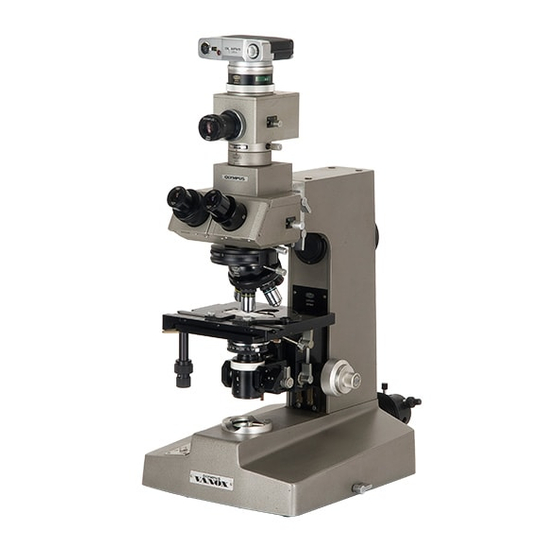Olympus VANOX Руководство по эксплуатации - Страница 26
Просмотреть онлайн или скачать pdf Руководство по эксплуатации для Микроскоп Olympus VANOX. Olympus VANOX 28 страниц. Universal research microscope

4. Focusing Procedure
Use the field of view eyepieces for focusing on the film plane.
Each field of view
eyepiece has a focusing front lens and a reticle with
4
frames, each frame indicating
the area covered by
a specific
power FK photo eyepiece. Several type field of view
eyepieces are available, according t o
the
film size employed.
4 1
Select the field of
view eyepiece matching the
camera back in use and insert
it
into the right eyepiece tube of
the
binocular observation tube, aligning locating
groove and locating pin.
2)
While looking through the field of view eyepiece, turn the front lens in screw
mount
t o
fncus on thc! double cross lines in the field.
3)
Bring the specimen detail to
be
photographed within
the frame
corresponding
to the
power of
the
F K
eyepiece
in
use and focus on the
specimen
with the
microscope fine adjustment knobs.
Make sure the light
path selector knob
on the observation tube is either on The white ( V J
or
yellow-green (CV) band.
(See page 22.)
Attachment G r n e r a
35mm Back
3
1/4" X
4 114"
Polaroid Back
4" X 5" Holder
120 Roll Film
We1 I-f ocused
Field of View Eyepiece
1
351
10
X
W F 10
X
~
W
F
1 0 X
~
W
F
l O X
Out of focus
When using photographic filters, place them into the filter holder at the light exit in
the microscope base.
For photography with black-and-white film:
G-533 (green)
: This filter
i s most recommended, since i t aids in obtaining photo-
micrographs of highest resolution and maximum contrast.
Y-48 (yellow)
.
Recommended as contrast filter when it is desirable t o emphasize
the blue color in the stained portion of a specimen.
C (cobalt)
: Not generally recommended
for
photomicrographic purposes since
it
reduces both resolution and contrast.
Use it for specific
applications only when
it
is desirable to emphasize yellow in the
stained portion
of a specimen.
